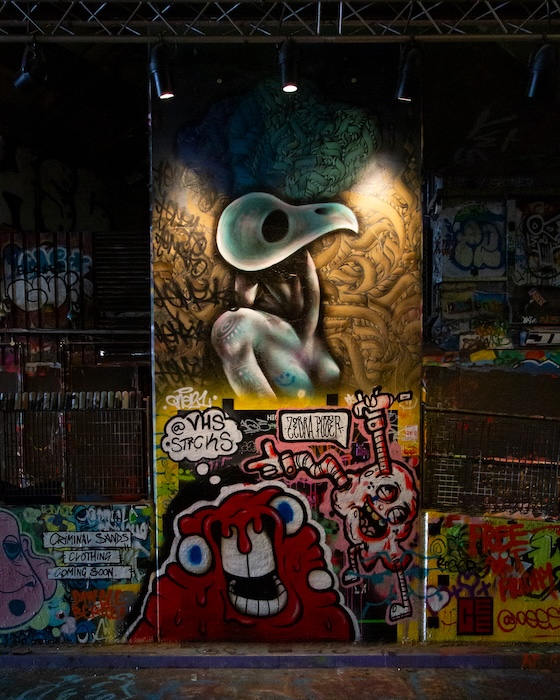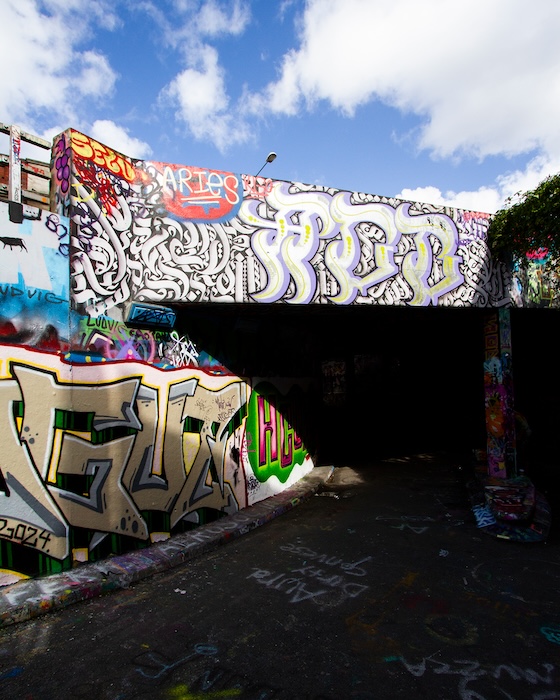Exploring London’s Largest Free Graffiti Space and Its Role in Urban Creativity.
Located on London’s South Bank, just steps away from the iconic London Eye, Leake Street Arches is a vibrant hub for graffiti artists and enthusiasts. Known as the London Graffiti Tunnel, it is the city’s largest free painting area—a legal space where creativity thrives without boundaries. Since its transformation in 2008, Leake Street has evolved into a dynamic and ever-changing canvas, shaped by layers of paint and the collective energy of its users. This legal graffiti space serves as a communal meeting point where writers, artists, locals, and curious visitors come together to interact and contribute to its ongoing transformation.

A Place That Never Looks the Same Twice
Leake Street Tunnel became one of my favorite places to revisit during my summer in London. Each visit felt like stepping into a completely new world. The walls—thick with years of accumulated graffiti—are constantly changing. On one visit, a bold, letter-based burner might dominate an entire stretch of the tunnel; on another, that same wall could be overtaken by an intricate freehand piece, with tags and throw-ups creeping across it like graffiti’s organic heartbeat.
One of the highlights of my time at Leake Street was exploring the tunnel with a group of loyal readers of this blog. As we wandered through the space, stepping into the occasional spray can mist and pausing to photograph freshly painted works, we reflected on the importance of places like this. Today, I want to share those reflections with all of you who couldn’t join that street art trip, exploring Leake Street’s unique role as a living, breathing part of London’s urban fabric, embodying the energy, resilience, and creativity of the city itself.

The Banksy Spark and the Graffiti Tunnel’s Beginning
From Rail Hub to Forgotten Tunnel
Before it became the Graffiti Tunnel, Leake Street served a practical purpose. Connecting York Road to Lower Marsh and Lambeth North station, the underpass sat beneath the Waterloo International train terminal. For over a decade, the tunnel supported rail activities, functioning as a taxi rank for EuroTunnel passengers, while its arches were used for storage. When the terminal relocated to St Pancras in 2007, Leake Street was left redundant. The taxi rank shifted, the arches emptied, and the tunnel fell into disuse.
Banksy’s Cans Festival: A Turning Point
The Leake Street Tunnel as we know it today was born in May 2008, when Banksy secured approval from Network Rail to host The Cans Festival. Over the course of three days during the bank holiday weekend, the tunnel became the stage for a blockbuster exhibition that attracted more than 30,000 visitors. Widely publicised, the festival reflected the growing mainstream appeal of street art in London, coinciding with a groundbreaking street art exhibition at Tate Modern. In many ways, The Cans Festival marked a turning point for the institutional recognition and legitimation of street art, with Leake Street playing a pivotal role.
The festival was semi-curated, with strict rules that only stencils could be used on the walls—no freehand graffiti was permitted. High-profile stencil artists such as C215, Blek le Rat, and Faile were invited to create works, while members of the public who brought stencils and paint were also given spaces to contribute. This mix of professional and amateur participation showcased the inclusive ethos of the festival, establishing Leake Street as an open and democratic canvas for creativity.

The success of The Cans Festival led to a second iteration, Cans II, during the August bank holiday later that year, coinciding with the closing weekend of the Tate Modern exhibition. These events ushered in a new chapter for the tunnel as a legal and ever-evolving painting zone.
Leake Street: London’s Authorized Graffiti Area
After Banksy’s Cans Festival and its sequel temporarily turned the tunnel into a semi-curated exhibition for stencils and figurative art, Leake Street evolved into a truly free graffiti space. Writers were granted unrestricted access to the tunnel, with no limitations on content, style, or quality. Open 24/7, it became a unique urban environment where the controlled creativity of organized events gave way to the spontaneous and unpredictable energy of graffiti culture.
Crucially, the absence of police interference solidifies Leake Street as a genuine safe haven for artists. This protection stems from the Railway Company’s refusal to share CCTV footage from the tunnel, ensuring that graffiti writers can create without fear of criminal investigations. In a world where graffiti often faces harsh legal consequences, this rare freedom makes Leake Street a meaningful and vital space for creative expression.
A Space for Writers, Not Street Art
While the initial festivals focused on figurative street art, the tunnel has since evolved into a space defined by type-based graffiti. Today, its surfaces are overwhelmingly dominated by tags, throw-ups, letter-based freehand pieces, and wildstyle graffiti, with figurative works becoming increasingly rare.
Graffiti writers continuously repaint the walls, adding new layers to the ever-thickening strata of paint. This organic, unregulated process ensures that the tunnel resists the neat uniformity of curated creativity. It remains a space for the graffiti community, where the emphasis is on the act of writing, layering, and contributing to an environment that thrives on collective expression. This raw, untamed essence distinguishes Leake Street as a haven for graffiti, not street art.
Leake Street as a Graffiti Ecology
Leake Street operates as a unique graffiti ecosystem, constantly shaped by collective participation and the layering of works over time. Open to anyone—regardless of age, background, or skill level—it thrives on inclusivity, unpredictability, and unregulated creativity.
Unlike curated urban art spaces that emphasize permanence or aesthetic appeal, Leake Street resists hyper-design, privatisation, and commercialisation, allowing graffiti to organically transform the tunnel through a communal process rather than individual authorship.
Leake Street: The Power of Self-Regulating Creativity
Leake Street thrives on self-regulation, where graffiti writers follow unspoken rules, respecting the impermanence of their work and the inevitability of being painted over. Creativity here is far from random—writers carefully plan placements, considering wall texture, colors, and the authorship of previous pieces. Temporary ownership emerges through backgrounds and techniques, creating order within the chaos. This resilience and the calculated, collective production transform the space without the need for top-down curation.

Leake Street: A Model of Urban Resilience
Leake Street exemplifies how mutual respect and self-regulation can sustain a vibrant, inclusive space. Writers create a cycle of painting, erasing, and replacing that keeps the tunnel dynamic and engaging for all who use it.
Social Benefits of a Free Painting Zone
Leake Street’s transformation has brought significant social benefits, including a reduction in crime and anti-social behavior. It fosters ownership, participation, and a strong sense of community between writers, locals, photographers and visitors, who interact with the space in diverse ways. This interplay transforms Leake Street into more than just a graffiti tunnel—it redefines urban spaces as dynamic and participatory, challenging the static, controlled environments of traditional cityscapes.

From Forgotten Tunnel to Graffiti Heaven
Leake Street demonstrates the potential of urban spaces to become participatory environments driven by their users. Built layer by layer (quite literally!), it offers a model for grassroots creativity and collective expression, redefining urban environments worldwide. It stands as a testament to collaboration and creativity, transforming urban spaces to reflect the energy and needs of their communities.
For more urban art discussions like this one, subscribe to my newsletter!

Discover London with my travel and street art map:





